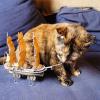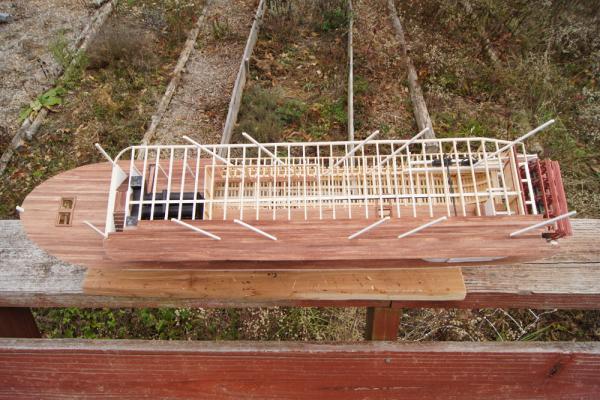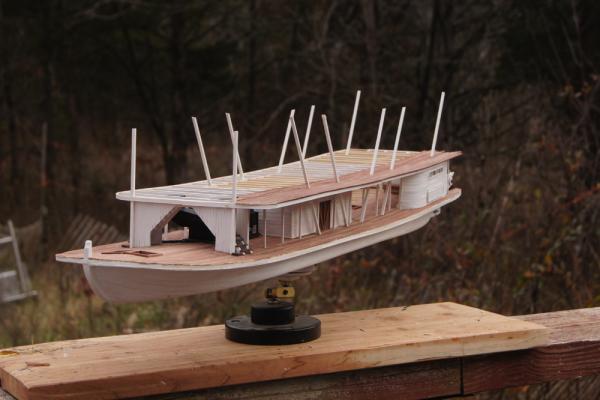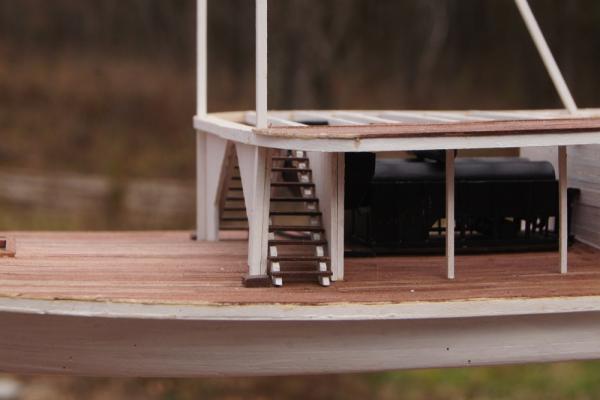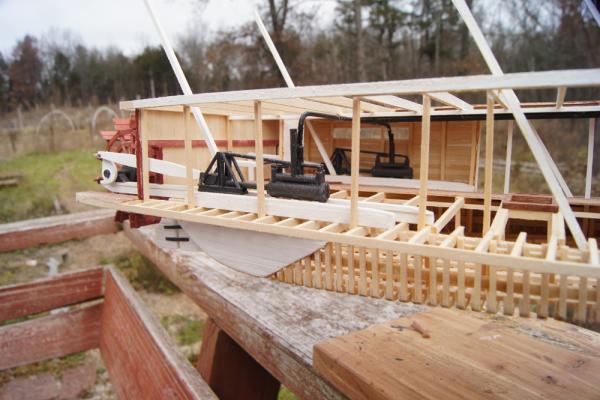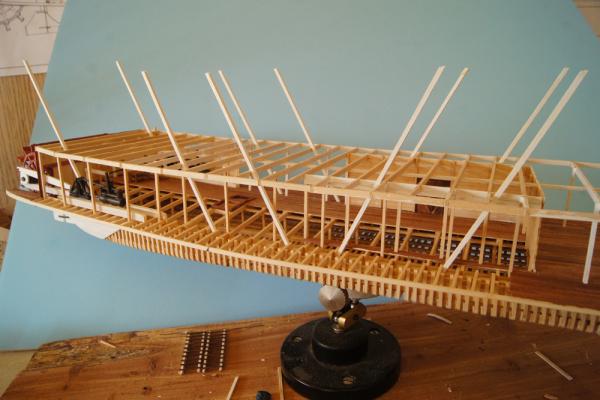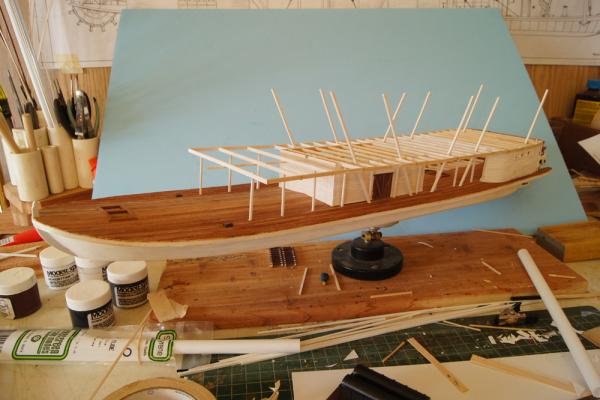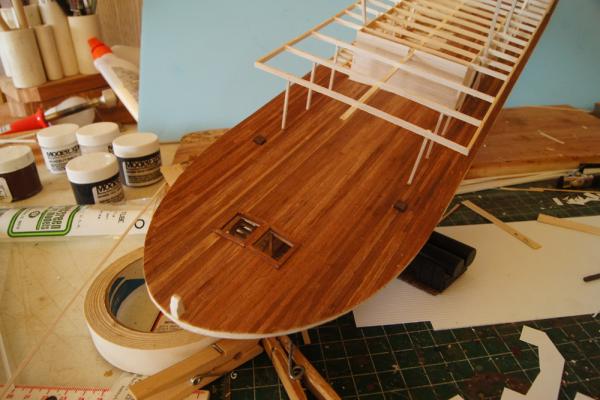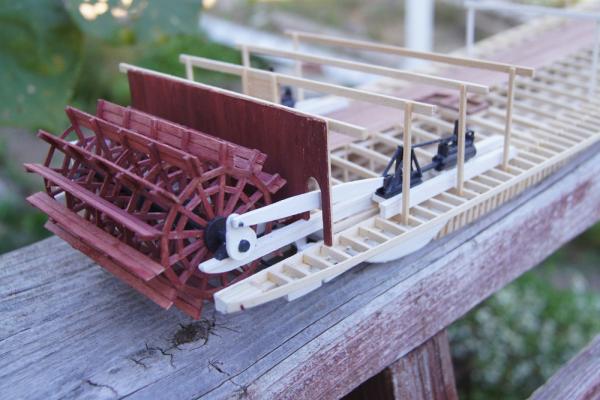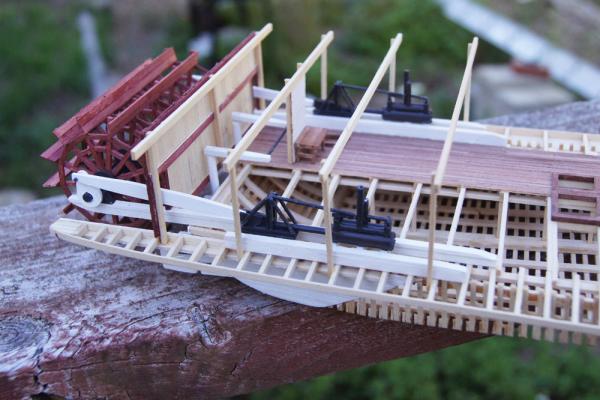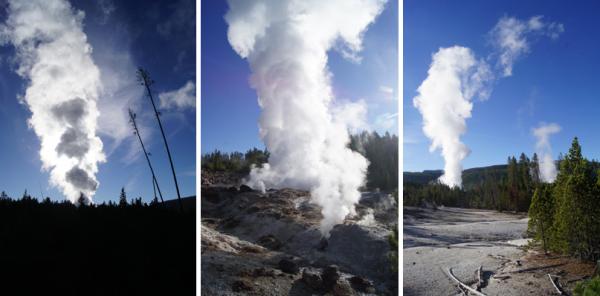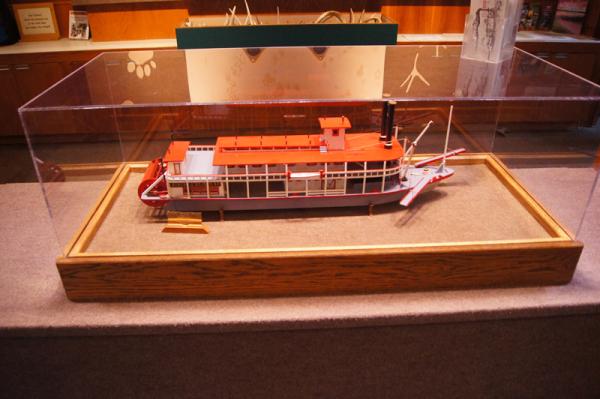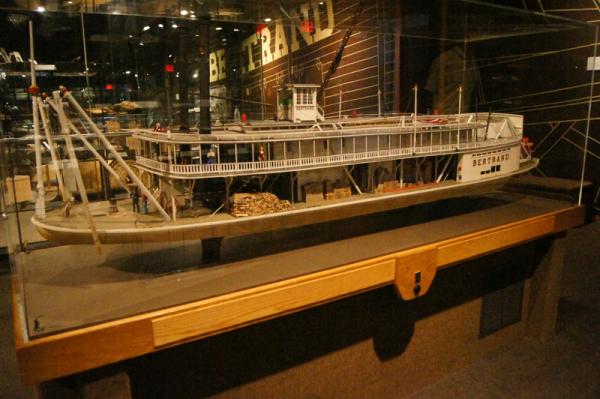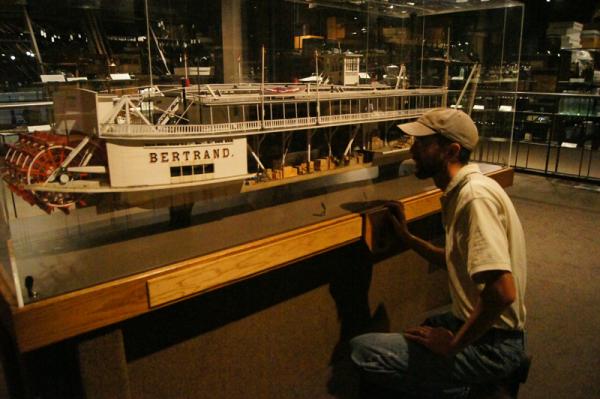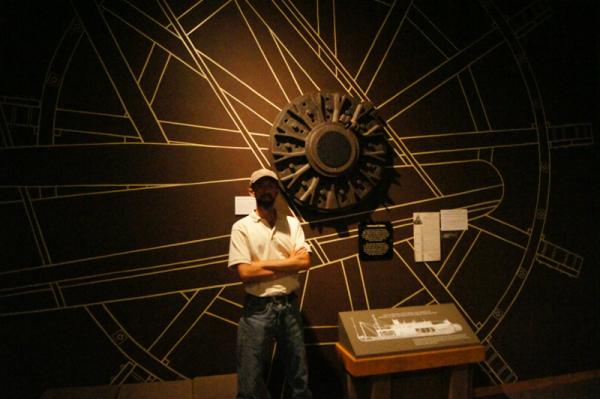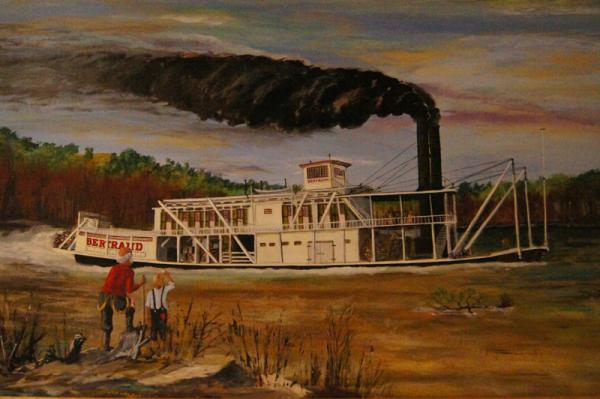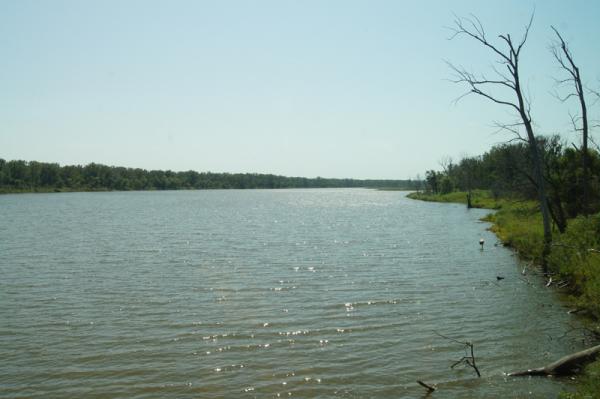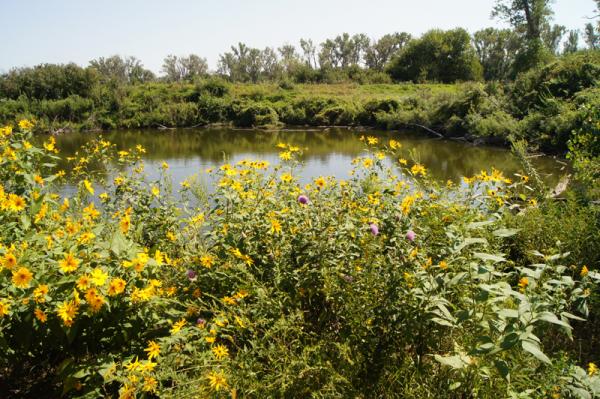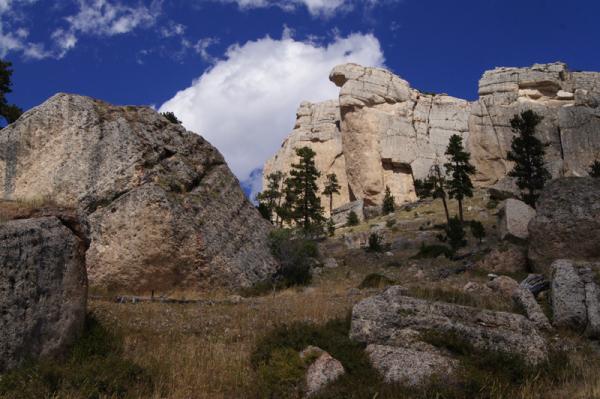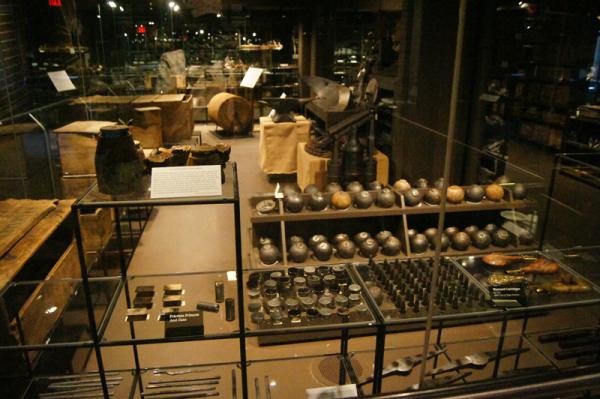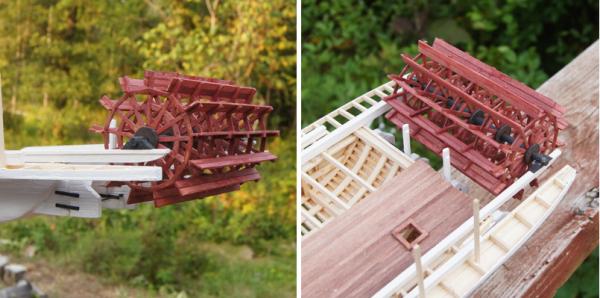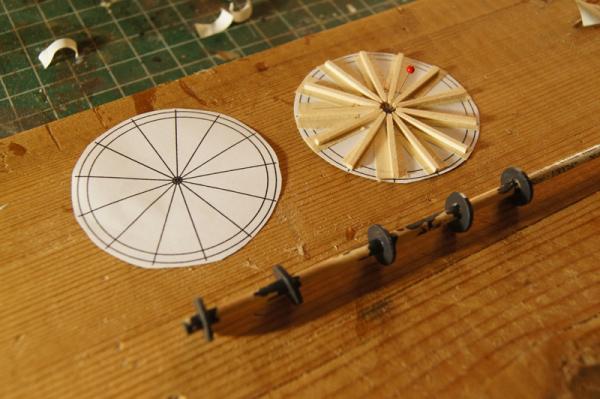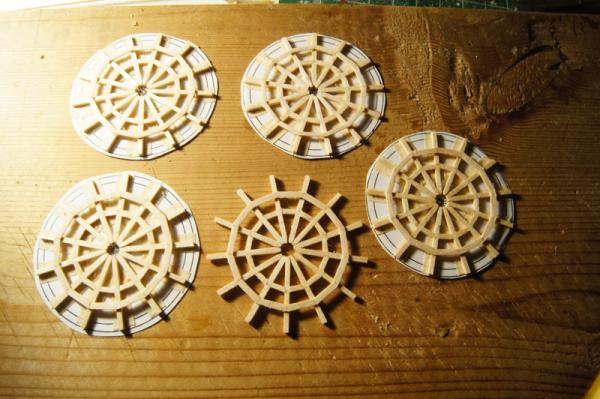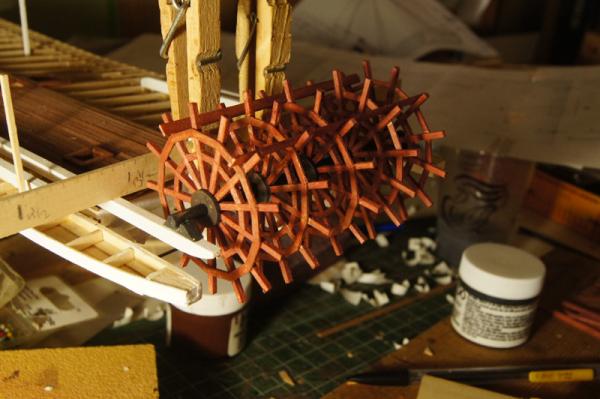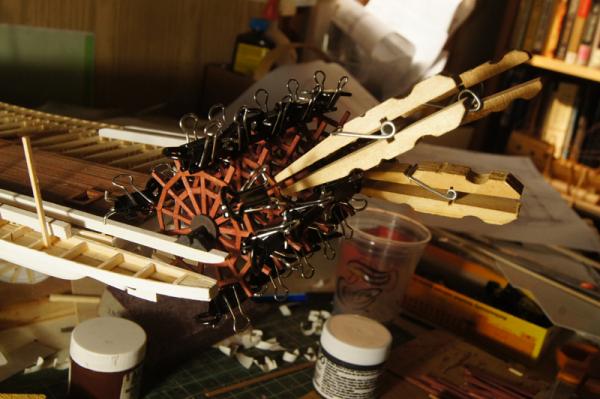-
Posts
3,420 -
Joined
-
Last visited
Content Type
Profiles
Forums
Gallery
Events
Everything posted by Cathead
-
Jim, yes, I actually went ahead and dealt with it just now. Stuck a long wooden stringer in through the open starboard side to the depth of the cut-off stack, marked the stringer on the outside edge of the boiler deck, then laid the stringer across the deck and marked its end on the deck. Having the steam line to follow made it really easy. Drilled a small pilot hole, widened it with a round file, and slipped a new section of stack down. Near-perfect match. Big exhale. I figured if I screwed up the first attempt, I could just place a figure or something over the "wrong" hole, but it's better to get it right the first time!
-
Glenn, I have a question which just occurred to me. In The Western River Steamboat, by Adam Kane, the author repeatedly refers to "the Red River wreck" saying that the boat's identity hadn't been confirmed (as of the 2004 publication date, anyway). It was an early boat, without hog chains. I just made the connection that this must be the Heroine you're reconstructing here? Unless there's another Red River wreck out there?
-
Well, she doesn't look hugely different than the last update, but some important progress has been made.The boilers are built and installed, as is the main staircase. I'm currently planking the boiler deck (the level above the boilers),and thinking/working ahead on the cabin area. Some detail of the boilers & stairs, both scratchbuilt. No one knows exactly what Bertrand's boilers looked like (or anything above the main deck), but this two-boiler layout is what's presented in Petsche's reconstruction, and approved by multiple steamboat historians he consulted with, so it's good enough for me. Wood is fed into the fireboxes at lower front, where a brick ash trough allows ash to be cleaned out and flushed away without setting the deck on fire. Note that the trough ends in a hole in the overhanging guards, where the ash can safely drop into the river. The brick is a strip of HO-scale brick paper normally used for modelling buildings. The fireboxes heat water in the two large boilers, which generate steam into the steam drum on top, which feeds through a single line back to the engines at the stern. The water for the boilers is drawn from the river using a "doctor" pump, seen just behind the boiler. Boilers and such are made from styrene, painted black and weathered with pastels. I made a miscalculation somewhere and didn't leave enough room between the cargo area and the boiler, so the poor doctor pump is sandwiched in there without enough room. I made it pretty detailed for this scale, but it'll never really be seen. Oops. Another view of boilers and stairs. I made the stairs by clamping two beams together, carefully measuring out each step's location, then cutting/filing the notches across both beams so they'd match. Then I mounted the beams on double-sided tape to hold them square, and glued on the steps. Worked like a charm. The boiler deck's edge looks rough, because I'm not going to bother finishing it until the whole deck is done and I can trim/sand it all together. Will need to do a bit of touch-up paintwork as well. This is actually true of the main deck as well, now that I look at the photo. If you haven't been following ggrieco's steamboat Heroine, WHY NOT? It's brilliant and beautiful, far above anything I can manage. After enjoying his intricate recreation of a steamboat engine, I thought I'd re-post a better photo of my own engines, just to make the contrast clear. These styrene approximations work well enough for me, they get the idea across, but the Heroine is something special. This photo also shows a mistake I made, which will be slightly tricky to fix. You can see how each engine is connected to the overhead steam line feeding from the boiler. Each one also has a separate exhaust stack that vents steam from each cycle. When I built the engines, I left these stacks cut off short, to make the assembly easier to install, reasoning I would install the vent stack later, before I planked in the boiler deck. It was, literally, not until I was reviewing this photo for posting that I realized I'd forgotten to go back and add the stacks before beginning deck planking, so the port-side engine is now buried. I'll have to very carefully measure/guess where that stack projects to and drill a small hole through the deck. The starboard one will just get installed the way I meant to, before the decking gets that far. And a final overhead photo. You can follow the steam line under the boiler deck to see where I'll have to drill a vent stack hole. The decking has progressed since I took this photo, I'm now about halfway across. I've also been working ahead on the cabin structure. I bent to peer pressure and began making my own doors & such, which I hope you'll like. Photos of those will come when I'm further along. The cabin presents its own challenges of construction, as the boiler deck has a sheer fore and aft which mean I can't just build the cabin square on the workbench and plop it down; it has to conform to the deck. I have an idea how to do this without going crazy, and will share the results when it succeeds (or fails). Meanwhile I've been staining more deck beams to stay ahead of the slow-but-steady progress on that front. For today's music, I present Marmaduke's Hornpipe, the "fiddle anthem of Missouri", named for Confederate officer John Marmaduke, who grew up along the Missouri River not far from my farm.
-
Y'know, you might as well just finish blowing our minds and make the danged thing operational. I'm a steamboat enthusiast but not much of an engineer, so won't be any help figuring out engine details. Happy to learn from you, though!
-
After making small-scale approximations of similar engines for my own build, it's really neat to see detailed, larger, precise reproductions for comparison. It always strikes me how small steamboat engines actually are; my mind wants them to be much bigger relative to the boat.
-
The Revell Bounty was my second plastic ship kit, and I thought it a nice model. I didn't have trouble with any of the parts, and it's large enough to be easy to work with; I also chose to add more detailed rigging, which was quite possible at its scale. It let me practice a few "custom" additions while being a straightforward kit to assemble. It still looks nice on the bookshelf, with its weathered sails and homemade stand.
-
I somehow just discovered this log. What a delight to have another western steamboat build here, though I'm in awe of your detailed metal work. You passed over the hull construction, if you ever want to go back and discuss that I would be quite interested. Also, as I don't know anything about this boat, is there any online info about it or the excavation? In any case, thanks so much for sharing this and I'll happily follow along.
-
Well, my beloved Royals have won the baseball World Series, and I'm back to work on the Bertrand. The main deck structures are complete, and I've mostly finished framing up the boiler deck. This was surprisingly difficult, as there's no flat frame of reference (the main deck curves in every direction). Getting the support posts vertical in both directions was quite interesting. I've been very bad about taking "process" photos during this stage, so you'll just have to imagine things. The only consistently flat frame of reference is, oddly enough, the bottom of the hull. So I made a complicated jig of solid wood strips clamped to the hull, from which I could extend vertical squares, onto which I clamped cross-ways strips, to which I could clamp the vertical posts. Fiddly, but effective. I also made strong use of the eyeball; I'd rather a line of posts LOOK straight relative to each other, even if they're slightly out of line relative to true vertical. Once the posts were in place, I began adding cross-pieces. Technically the boiler deck should have a slight bit of camber to it, but I decided that would be too difficult and would be barely visible at this scale, as most of the deck will be covered by the cabins. The more significant camber of the main deck shows up nicely, and is sufficient for my taste. Thus the deck is flat athwartships, but curves gently fore and aft to follow the rise of the main deck in both directions. I finished planking the main deck as far I as intend to; this extent will allow the model to look complete from a port 45-degree angle fore or aft, but still leaves plenty of internal view from the starboard side. It's a little rough in places, but will have to do. I'll put a crate or something over a few plank ends that stick up more than I'd like. View from the open starboard side. I've also finished installing the hog chain braces; these angled posts support metal rods running fore-and-aft, with turnbuckles on them, which keep the long, narrow hull from sagging/hogging. I won't install the actual rods until near the end of the project, as they'll be in the way, but needed to do the braces now as they extend through multiple decks. They're intentionally a bit longer than necessary, so I can cut them off just as I like them once I finish the superstructure. Currently I'm building the boiler assembly, which sits just forward of the cargo shed on the main deck. I intentionally haven't installed the vertical support posts at the front of the boiler deck, to allow me to slide the boiler in there. Once it's in place, I'll finish that area and install the staircases (already built) just in front of the boilers. I think things will go rapidly for a little while, now. Install the boilers, connect them to the engines with steam lines, plank in the entire boiler deck, and then move on to building the cabin area. I still have to decide whether to order a bunch of styrene windows and doors, or try to make my own out of strip wood. The former would be far faster and more consistently detailed, but more expensive and hard to make look just like the surrounding wood. The latter would take a long time, but be a lot cheaper and fit in better if I can make them realistically enough. I'll decide once the next deck is done. I'm holding out hope of reaching my goal to complete this model by the end of the year. Luckily the approach of winter means nice long evenings for quiet model work. She's certainly starting to look something like a steamboat. In the meantime, here's a fine Ozark fiddler playing "Jefferson City", one of Bertrand's ports of call on her way upriver.
-
Peter, I agree on the inherent appeal of nice lines. When deciding on a future ship build, Mrs Cathead was unconvinced of several ships I found historically interesting (Beagle, Charles Morgan, Endeavour) because they looked to stolid and square. When I showed her a few schooner rigs she was hooked.
- 293 replies
-
- pickle
- caldercraft
-
(and 1 more)
Tagged with:
-
Good stuff, Ken, thanks. The previous extent of my knowledge on this topic came from visiting the Cairo in Vicksburg. BTW, that link doesn't work as entered; it needs an http:// in front of it, at least in my browser. Just a note for anyone else who tries to follow it.
- 80 replies
-
- choctaw
- heinkel models
-
(and 1 more)
Tagged with:
-
Just discovered this, and my mind is blown, knowing nothing about this kind of model. And the prototype is pretty unique, not a riverboat I'm at all familiar with. Thanks for taking this on and expanding my horizons. I remember doing some origami as a kid, but this is something else indeed.
- 80 replies
-
- choctaw
- heinkel models
-
(and 1 more)
Tagged with:
-
Well, she doesn't look much different at first, but some detailed work has been done. After a fair amount of consulting and cogitation, I settled on a design for the engines. As we have no idea what Bertrand's machinery actually looked like, I went for a representative approach; something that would capture the spirit of typical steamboat engines for the period. Something like this: Experts will recognize some missing details; some will be added as I progress, some I didn't think I could replicate well enough to include. For example, I haven't yet added any of the overhead piping that brings steam to the cylinders from the boilers (forward), or the chimneys for cylinder exhaust, both of which will be easier to do later as I progress on the superstructure. But the overall effect is good enough for me. Also completed are the tiller arms, and one side of the bulkheads that separate them from the engineer's main work area. The starboard side won't be built to keep the view lines open from that direction. Note the scratchbuilt workbench forward of the bulkhead. That was a fun little side project. Photos from the museum model were useful in getting drivers reasonably right. I also built the aft bulkhead, painted red as on most steamboats of this era. The wheel really turns, though the drivers don't (I wasn't up for making working pistons). Later I'll be adding the various bracing that supports the weight of the wheel, but not yet. Next up, framing up the rest of the main deck superstructure and walling it in. Then the various angled hog chain braces and their iron rods, then finishing the decking, then building the boiler and remaining machinery and running the necessary steam lines. No idea when the next update will be. Baseball playoffs will be a major time sink for the next month until the Royals' season is over. EDIT: upon re-reading, I fixed an embarrassing error. I referred to the main and boiler decks as the same thing, which they're not. The boiler deck is one level above the main, despite the boilers themselves being on the main. I knew this, but it's easy to confuse if you're not paying attention. I've never seen a convincing explanation of why the boiler deck is called that, but it has always been so on steamboats to the extent of my knowledge.
-
I find that I need a personal connection to the prototype to really be motivated. For example, even though I'm fascinated by sailing ships, a number of my early models have been based on Missouri River craft because that's where I live and it's a favorite historic/geographic area for me. While I don't like machinery overall and would place steamships in general pretty low in my list, these local craft have too much relevance for me to ignore. I built the Bounty Launch because I've been rereading those stories since high school; I also built a plastic Bounty for the same reason. I find it too daunting to choose among all the possible ships out there, so finding that personal connection to something helps winnow the choices. I will never build all the ships I find attractive, and just have to come to terms with that. I've also slowly looked for projects that will help improve my skills, without getting in over my head. While I'd love to build a large ship, my next two will likely be a longboat and a topsail schooner, to help develop skills in hulls and rigging, toward the someday goal of tackling a true ship. I will also likely squeeze in another steamboat. Finally, I like being different, and finding my own path. Building riverboats certainly accomplishes that, and I hope to find a unique twist on any regular sailing craft I attempt, too.
-
I considered this as a scratchbuild project, there are no kits I know of. There is a lot of information out there, though, if you wanted to tackle it yourself. Here's just one example. A replica exists, I believe in Ireland, which occasionally travels (Mrs Cathead saw it once in the US). Since I've become involved in ship modelling, I've been surprised how few kits there are of explorers' vessels. No Darwin's Beagle, No Shackleton's Endurance or Caird, just to name a few, despite plans and information being available. I'd love to build the Beagle, but scratching that is beyond my current talents.
-
By Jerome Petsche. It's the main reference for this build, being the official record of the archaeological excavation. My copy holds a permanent spot on my workbench, and has its spine thoroughly broken from scanning the various drawings. I appreciate the thought, though.
-
Matt, I suspect you're thinking of the steamboat Arabia, discovered and excavated by a private group near Kansas City. They built a really neat museum right in downtown KC, a must-visit for any steamboat aficionado. I don't think very many steamboats have been recovered, at least in the Mississippi drainage. I don't know as much about the east or west coasts, but rivers there tend to be rockier and so wrecks are even less likely to be preserved. The Missouri and lower Mississippi rivers are best suited for preserving wrecks, as they're sediment-dominated and so could easily and quickly cover a wreck with sand/mud and preserve it. Anything that wrecked on, say, the upper Ohio or Mississippi or even the Columbia would be less likely to stay in one piece long enough to be buried. A ton of steamboats sank on the Missouri, it was a difficult and dangerous river to navigate. I've seen estimates, based on historic records, that there's a wreck location every few miles along much of the river. The average boat lasted only a couple years before sinking, burning, or blowing up. That said, there are good reasons very few have been recovered. One, lots of wrecks didn't stay intact; they burned, blew up, or were torn apart by the current. Two, those that remained intact were often salvaged quickly, leaving little behind. Three, those that sank intact but weren't salvaged were quickly buried by the river's ever-changing course, such that within days to weeks the boat was buried beneath a sandbar, island, or other landform, where it was quickly lost. The only way to find them now is with a metal detector, and that requires being very close to the wreck, which requires figuring out nearly precisely where it is, a very difficult procedure when you're standing in the middle of thousands of acres of soybeans or corn trying to find a river channel from the 1800s. This is all the more true because one of the top salvage priorities was the iron (engines, boilers, etc) so there are likely plenty of hulls left down there with not enough metal to trigger a detector. The Missouri's current channel bears only a tenuous relationship to its various courses in the 1800s; same for the Mississippi. So it really is like looking for a needle in a haystack.
-
Completely natural. As a former geologist, I can assure you that channel movement is a basic function of rivers. A lot of factors go into how much and how fast a channel moves, including the bedrock or soil underlying the river, the discharge and its year-round variability, bank vegetation, etc. The Missouri was legendary for being an especially shifty river, though. Don't have time to go fully into it right now, but there are some great stories and imagery to prove it. Modern people get a false sense of security living along rivers that have been dammed and channelized into, basically, controlled flumes, but that's not a natural condition.
-
Well, I've returned from the wild and will eventually get back to modelling. First, though, some relevant photos from the Bertrand museum and elsewhere. A few introductory notes on the museum. As the Bertrand was discovered, and excavated, within DeSoto National Wildlife Refuge, it became the property of the US Fish & Wildlife Service. Thus they built the museum as an add-on to a visitor's center otherwise dedicated to the refuge. It's a nice museum, but not one staffed by "steamboat people", per se. It's just a wing of the larger center. We had very little time there, even less than I had intended, because of the very long drive that day (we had to make it from central Missouri to western Nebraska before dark). A cute, if primitive, Bertrand model in the lobby. One of the museum's centerpieces, a large-scale model of Bertrand; me for scale. This is a beautiful model, with complete interior, but in several places it departs rather severely from the archaeological drawings of the boat. The most blatant difference is the relationship between the main deck and the boiler deck just above. In the drawings, and the accompanying documentation, it's concluded that Bertrand's boiler deck extended as far as the width of the main deck and was supported by vertical stanchions between the two, on the very outer edge of the decks. On the model, the stanchions are set well inboard, with a set of curved supports ducked in under the boiler deck. I don't know why the discrepancy exists, since the model was almost certainly made after the excavation (no information was provided). A painting of the Bertrand, by the same artist/illustrator who drew the graphic reconstructions included in the archaeology reports I'm working from. Note that he portrays the stanchions correctly, as vertical supports at the very outer edge of both decks. EDIT: I forgot to note that the cute, primitive model shown above DOES get the stanchions right. A nice touch; one wall of the gallery is a full-size outline of Bertrand's aft third (roughly), with an actual paddlewheel hub mounted within. Me for scale. The gallery includes a huge collection of artifacts salvaged from the wreck, which are a day's worth of contemplation for a history buff. Unfortunately, as you can see by the photos above, the lighting is kept very low for preservation reasons, making photography a real, well, hassle. This shot gives some sense of the gallery's scale. In the foreground are various munitions from the wreck, which I thought might be of interest to some of you. For example, several racks of howitzer shells and a stand of .50 caliber Maynard cartridges. One assumes these were part of consignments for various Army posts on the frontier. The stretch of river on which the Bertrand sank is no longer part of the mainstem Missouri River, which changed its course quite regularly before being channelized and controlled by the US Army Corps of Engineers. The location is now part of a large oxbow lake, a former bend in the river now cut off by a straighter channel and left as a horseshoe-shaped lake. The site of Bertrand's sinking is on the opposite shore, about as far as you can see. And here is the actual site, the pit left over from excavation now filled with water and overgrown with shrubbery. Bertrand is still down there; once the teams had recovered the cargo and documented the hull, they left her be. It's perhaps 100 yards in from the old channel, in what used to be a field, where it was left by an early shift in river channel. The active river now is maybe 1/2 mile away. Finally, a few other images from the trip, most of which was spent hiking in Yellowstone and Grand Tetons National Parks. I could bore you all with lots of imagery of backcountry thermal features, wildlife, and geological eye candy, but will restrain myself to these two, whose relevance should be apparent: This is Steamboat Point, in the Bighorn Mountains of north-central Wyoming. It's a nice basic climb of 800' vertical feet or so, giving a clear 360 view of the east slop of the Bighorns. And this is Steamboat Geyser. It erupts unpredictable and rarely, the last eruption being just over a year ago. Here it's just steaming in the cool, crisp, morning air, but even so it reminds one of a boiler hissing away gently, awaiting the engineer's touch to build pressure once more. Next up for my version of the Bertrand are the engines, for which more research and planning is needed. I also need to get everything else in life back under control after two weeks away. But I hope you all enjoy the images above.
-
The paddle wheel is done! Here's how I approached it: While the Bertrand's wheels didn't survive to be recovered, one of the wheel hubs did, so we know the wheel had thirteen spokes. Using the estimated wheel diameter of 18', I laid out a template on my computer of 13 evenly divided spokes with a scale diameter of 18', and printed out five of them. These would form the basis of my wheel. Meanwhile, I chose a dowel of the correct thickness for an axle. Then, for the hubs, I glued two pieces of styrene together, traced a series of circles of the right diameter (based on the recovered hub), and drilled axle holes through them. Then I cut out the rough circles with a hobby knife, smoothed them round with file and sandpaper, and painted them a dull metal black. Apologies for the quality of this photo, but it shows the assembled wheels. I mounted each paper pattern with a pin at center, then laid thin strips of double-sided tape along each spoke. This let me set the spokes in exactly the right orientation, before attaching them with carefully cut and fitted frame pieces. A careful look will also notice the inner ends of the spokes sanded to a slight angle to make them all fit together at the hub. On the real thing, the hub would have had sockets to hold each spoke, but I didn't think I could simulate that acceptably at this scale, so didn't. Better no detail than bad detail, in my opinion. As you'll see, it's almost impossible to tell once the wheel is finished. Removing the wheels from the double-sided tape was tricky, and I broke one by being too aggressive. It was fixed. After sanding and shaping with a file, I painted these with diluted red paint. A bit too diluted, as I overdid it on several wheels and the diluted paint dissolved the wood glue holding these together and the wheels began to fall apart. With some very careful reassembly, a coat of glue along all surfaces, and some appropriate riverboat language, I salvaged the wheels no worse for the wear. Then I attached each hub, lightly weathered everything with brown pastel, and was ready to move on. Now the real fun began. I carved the pillow blocks which support the axle, painted these and the axle, and began assembly. I'd wanted the wheel to turn, so had no intention of gluing the wheels onto the axle. I strung all five wheels loosely along the axle, glued on the pillow blocks, and glued the whole assembly to the support arms on the hull. Above you see me test-fitting the first paddle planks. I marked a few of these with the exact locations of each wheel, and clamped them on to hold the whole structure stable. Then I started gluing on other planks, all of which had been pre-painted at the same time as the wheels. Here's the hedgehog effect of the wheel covered in clamps. I glued every other plank to give the clamps room, then went back and filled in the gaps when the first round was done. Then I did the second, outer layer of planks. This went quickly and easily. And here's the final result. The five wheels are near perfect copies of each other, such that the planks lined up perfectly. Another reason I left the wheels to turn freely on the hub, was to ensure I could get the best possible alignment between them. There were a couple spokes not quite right, a legacy of the dissolved glue and repair, but I can easily turn the wheel to hide them down by the rudder. It's really quite fun to sit there and turn the wheel gently. I may want to add some more detail, such as the bolts and straps that hold the paddles to the wheels, and some detail to the outer hubs, but not right now. Someday it would be fun to build working machinery for such a paddle wheel, but this wasn't the project. The driving arms will attached permanently to the axle, and will not be in motion; only the wheel itself moves, unattached to the axle. It's good enough for me. I think it looks pretty neat with the wheel on, a real step forward toward looking like a steamboat. Now I'm off on vacation, two weeks hiking in Yellowstone National Park in northwestern Wyoming. As we're both former geologists, and Mrs Cathead worked at the park for three seasons many years ago, we're quite excited to return. On the way, we're stopping at the Bertrand museum at DeSoto National Wildlife Refuge just north of Omaha, Nebraska, a place I've been many years ago but am now very excited to return to. The museum is at the location of Bertrand's sinking, and is full of recovered cargo from the boat and various other exhibits. I'm also hoping to collect some driftwood and sand from the Missouri River at that location for use in a future display base. So this build will be on hold for a bit, but for a good cause.
-
Hah, Matt, my first reaction was GOOD GOD NO! But you may well be right; I did quite enjoy framing this one up, and it would make an excellent boatyard diorama. The problem is, there are just so many interesting projects and so little time. I already have my next build purchased, making use of the M-E 50% sale, after that I may want to scratchbuild a sidewheeler for once, then there are all the real ships to consider. So many options! Thanks for reading. I find it hard to take praise from all of you whose skills are so much beyond my own (you will likely laugh to see my machinery compared to your work), but appreciate the good will nonetheless. In the meantime, I may well be able to post pictures of a finished paddlewheel before I vanish for a few weeks.
-
That works both ways, as this kit is my next build whenever I finish the Bertrand, and you can be danged sure I'll be revisiting this log.
-
I haven't made much visible progress in the last few weeks, but have been doing a lot of preparatory planning for the complicated next step(s). First, here's the one major achievement: the rudder assemblies. I built these up from multiple layers of wood, making the actual rudders a bit thicker than the wings that link them to the hull. I based the curve in the latter (where they meet the hull) on the mold I used to bend the stern frames in the first place, then carved/sanded the curve to its final fit. The hinges are just thin strip styrene; at this scale I don't have the skill to fabricate true hinges, and these will be well hidden behind the paddle wheel. Boats like Bertrand used four rudders, two inboard masters with tall tiller posts that link to the steerage assembly, and two outboard slaves linked to the masters by hinged rods. I simulated these linkages with more thin strip styrene; again this detail will be almost entirely hidden on the finished model. I'll add the horizontal tiller extensions once I start laying out the engine room properly. The rudders had to be the next project, as I needed the boat upside down to do them properly, and once I start building up the superstructure it'll be a LOT harder to turn her over. I've also been making slow headway on the deck planking; slow because each line of planks has to be measured, cut, glued, and allowed to dry before the next goes into place. This is about as far as I'm going to go for now, as soon I'll need to start installing various vertical posts for the superstructure, which extend into the hull. Once I have the framing in place, I'll finish planking around it. This, at least, gives a sense of the planking's appearance (before any sanding). I've been intentionally staining planks with different dilutions, to discourage uniformity, and like the result so far (sanding will mute it slightly). Now comes the fun stuff, machinery, which I intend to tackle in this order: Paddlewheel Piston engines (which link to the wheel), located roughly behind "Bertrand" in the drawing above Boiler assembly (which links to the piston engines), located near the bow, forward of the two white cross-pieces I've already installed (see photo 2). Fabricating these will take quite some time. I intend to use styrene, of which I have a diverse supply from my model railroading endeavors; I'm used to it and have no experience in metal working. When painted and weathered, it gives a nice approximation of metal, suitable for my purposes. It may be a month or more before I update again. August is a busy time for me, and we are planning a two-week vacation in September. So I will likely not update this log again before late September, depending on how much work gets done. Thanks for your patience with my skewed priorities, emphasizing worldly pursuits over boat-building!
About us
Modelshipworld - Advancing Ship Modeling through Research
SSL Secured
Your security is important for us so this Website is SSL-Secured
NRG Mailing Address
Nautical Research Guild
237 South Lincoln Street
Westmont IL, 60559-1917
Model Ship World ® and the MSW logo are Registered Trademarks, and belong to the Nautical Research Guild (United States Patent and Trademark Office: No. 6,929,264 & No. 6,929,274, registered Dec. 20, 2022)
Helpful Links
About the NRG
If you enjoy building ship models that are historically accurate as well as beautiful, then The Nautical Research Guild (NRG) is just right for you.
The Guild is a non-profit educational organization whose mission is to “Advance Ship Modeling Through Research”. We provide support to our members in their efforts to raise the quality of their model ships.
The Nautical Research Guild has published our world-renowned quarterly magazine, The Nautical Research Journal, since 1955. The pages of the Journal are full of articles by accomplished ship modelers who show you how they create those exquisite details on their models, and by maritime historians who show you the correct details to build. The Journal is available in both print and digital editions. Go to the NRG web site (www.thenrg.org) to download a complimentary digital copy of the Journal. The NRG also publishes plan sets, books and compilations of back issues of the Journal and the former Ships in Scale and Model Ship Builder magazines.


